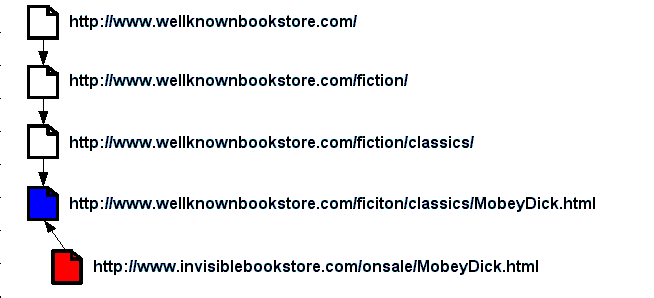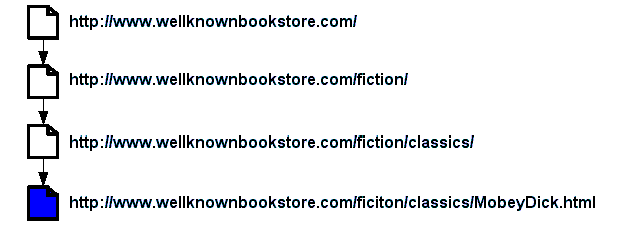Suppose you own a corner bookstore and have landed 50 copies of Moby Dick at 10 cents a copy. Say you would like to sell them at the cut-rate price of, say, $1.00 a copy. You maintain a small retail web site at invisiblebookstore.com. The site allows a consumer to purchase a book. Now, as a bookseller, you know the book market, and know where consumers go to in order to purchase books on line. Let's say you know there are a lot of buyers who go to wellknownbookstore.com. Further, assume you too have visited wellknownbookstore.com's web site, and have found a public, static web page there specifically about Moby Dick (represented by the blue box in Figure 2.4). In so far as a user can order Moby Dick from the web page, it serves as a point-of-sale page for Moby Dick wares at wellknownbookstore.com.
You calculate that visitors to this last page http://www.wellknownBookstore.com/fiction/classics/MobyDick.html are interested in Moby Dick, and some percentage of them use link aware tools that can make link-topological queries. So you author a page containing a link to this last page and register it with Ila. The red box in Figure 2.5 represents your newly created web page.
Figure 2.5. invisiblebookstore.com Advertises Its Moby Dick Sale By Linking to wellknownbookstore.com

Now, if a user visits the blue page, they can use Ila to see your red page and compare what you (invisiblebookstore.com) have to offer versus what wellknownbookstore.com has.
More realistically (if you suspend your disbelief just a while longer), you will find you are not the only player in this Moby Dick space. If a number of other booksellers employ the same linking strategy, then we will have a tiny marketplace where buyers and sellers of Moby Dick wares meet.
The white boxes in Figure 2.6 denote other booksellers' Moby Dick pages, and the blue page is just a consensual landmark, a reference point, in this web locality.
We can continue tangentially along this dreamscape:
The Booksellers' Guild crafts a simple XML standard to describe books for sale, and instead of simply linking HTML documents to the consensual hub, the sellers standardize on the new format. Now when users search the Moby Dick web locality, client-side software agents parse the backlinked XML content and rank the Moby Dick wares according to the criteria specified by the end-user. Moreover, the user is free to pick from a plethora of linked software agents. What has emerged is a location-transparent, distributed, organic, evolutionary micro marketplace. It's a town square. It's a bustling, chaotic bazaar with cheap real estate. All transactions are end-to-end; no property managers, no intermediators; no rules except consensual ones.
While the above might conjure a chaotic universe of interlinked content and executable code, the situation is not as bad as it seems. Quite the contrary. Link awareness is what you make of it. Every data structure ever devised, after all, is a subset of some connectivity graph. Every tree, every relational schema, is representable with a graph, a web topology.

